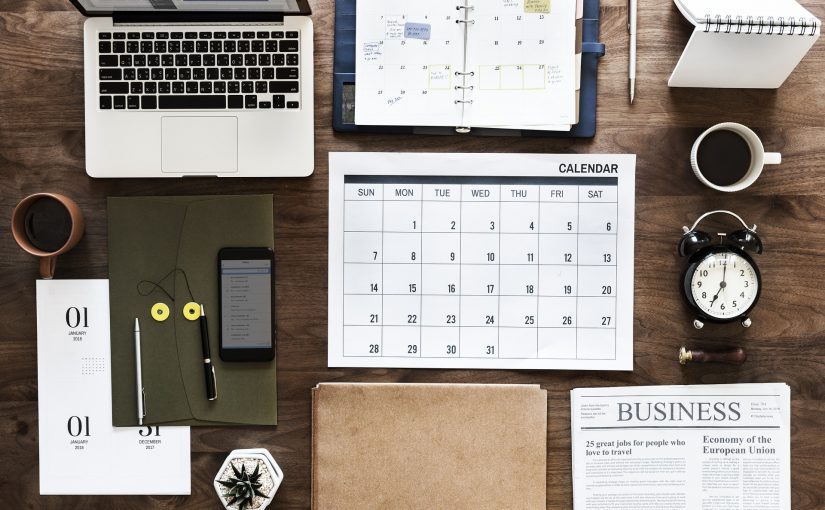Summary
I’m always asked how I organize myself with regard to my private and business tasks and how I manage my information. This article gives a brief overview of the tools and principles I use every day.
Task Management
I manage my tasks depending on my project environment. If I am in a smaller team, I mainly work paper-based regarding my task management. The basic principle of this system is based on Stephen Covey’s weekly planning from [The 7 Ways to Effectiveness*]. I created the week plan in this file and I print a DIN A4 sheet landscape for each week of the year. I place the sheets in the lovingly configured Roterfaden-Taschenbegleiter. The principle behind the Covey template is first to note the important things / strategic goals and the associated tasks in the weekly plan (left column). Appointments and the derived tasks then turned into the daily planning. It is important to work with pencil, because rescheduling is often in demand.
While working in larger teams, I exclusively use an electronic task management system such as MS SharePoint (task lists with MS Office Integration) or Trello (Kanban Board), because task delegation and mutual transparency are very important there. I then manage my personal tasks in Todoist*. With this app my tasks on desktop, the tablet and the mobile phone are relatively easy to create (because that is the most important feature!). If you first have to open an app for a long time or something similar it takes too long and the thought is often already lost. At home I linked my Amazon Echo* with Todoist, both for the shopping list and especially for the to-do list.
I find the change (depending team size) every couple of months between paper-based and electronic systems beneficial, because it “cleanses” the process and promotes a renewed awareness of the principles. In general, my recommendation is to start with the paper-based system in any case, because the principles are easier to apply and graphically more conscious (because the overarching goals are noted directly next to the daily tasks).
Document Management
I scan my paper documents, which are important/I need to keep, with my ScanSnap IX500* (very fast double-side multi-feed scanner) and with a press of a button I place the documents directly into Evernote* and also into Dropbox*. I don’t just trust the proprietary Evernote system (who knows if this provider will still exist in 20 years), but I also automatically save the files locally and in the cloud. The advantage with the ScanSnap Scanner is that the documents are also scanned directly via OCR and therefore the saved documents can be searched directly via full text search. When I am on the road, I scan the documents on my mobile phone with the app Scanbot (also with OCR-function also for multi-page documents) and save them in both places. Application for mobile scanning are mostly warranty receipts when shopping or receipts for travel expense accounting. I put the important paper documents classically in folders, because I don’t know if I can still use Evernote, PC or something similar in my old age. All not important but already scanned paper documents go directly into the trash.
For people who don’t want double coverage, I recommend the purchase of a Bates Numbering*. Apply the consecutive number with the stamp to each document before scanning, then filing by number and not by subject area in folders. Then it is ensured that as few physical folders as possible are needed and that the document will probably be found faster (via the consecutive number) compared to my structured filing. As I said, in this case you always have to search for the document first on your PC or in Evernote and then for the paper document using the number. Since I’m not sure if I can always ensure that, I have a structured paper file as a backup, which is admittedly more time-consuming.
I also save important internet pages in Evernote. Then I can always access them with a full text search. Alternatively I use the app Pocket, if I just want to save the pages for a short time, in order to read them later once.
Sort Thoughts
To sort my thoughts, also for such blog articles I use SimpleMind Pro on the desktop and on mobile phone and tablet. It’s nice that you can synchronize all mind maps to e.g. dropbox. What I especially like about SimpleMind is the completely free positioning of the “branches” of the mind maps. This is not always so easy with other mapping programs. In addition, the price for the apps is acceptable.
An interesting combination of possible task management tool and thought structuring tool is workflowy.com* for all “who think in lists”. Here you can record meeting minutes, ideas, tasks and everything else (also divisible in the team). In my opinion the ideal tool for the list thinkers mentioned. A mobile app is also available.
Meetings And Workshops
Timing in meetings and workshops: Here I use a real TimeTimer* or the original app.
To look up sketch notes I also use the app “Visual Helferein” and “Iconfinder” in workshops.
So much for the approaches and tools I use. Probably I didn’t think of everything. Have I not covered a task? Then comment below and I’ll be happy to complete the article.
The links marked with an asterisk (*) are so-called affiliate links. If you click on such an affiliate link and buy through this link, I get a commission from the relevant online shop or provider. The price does not change for you.
